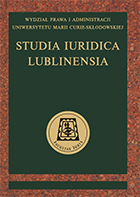Instytucja przymusu osobistego dłużników w sprawach cywilnych na ziemiach Królestwa Polskiego w latach 1815–1875
The Institution of Coercion of Debtors in Civil Matters in the Kingdom of Poland in the Years 1815–1875
Author(s): Justyna BiedaSubject(s): History of Law, Civil Law, 19th Century
Published by: Wydawnictwo Naukowe Uniwersytetu Marii Curie-Sklodowskiej
Keywords: history of law; Polish Kingdom; Napoleonic Code; civil procedure; foreclosure;
Summary/Abstract: The Napoleonic Code, which was in force since 1808 first in the Duchy of Warsaw and then in the Kingdom of Poland, provided for the institution of personal coercion in civil matters in Title XVIII (Book III – On Different Modes of Acquiring Property). It was an enforcement measure consisting of sending the debtor to prison in order to force him to fulfill his obligations. Initially, the detention did not result in cancelling the existing debt or did not exclude the possibility of carrying out a further enforcement procedure towards the debtor. Debtors were initially kept in detention centers or taken into police custody. Separate penitentiary bodies were appointed by decision of Administrative Council in 1832. The prison service as well as provisions of the Civil Procedure Code including detailed procedures for the use of coercive measures against debtors, have been defined both in the decision of the Administrative Council of 13/25 September 1832 and in subsequent administrative regulations issued by the Government Commission of Internal and Spiritual Affairs in 1848 and 1859. The 1848 regulations referred to civil jail located in Warsaw at Leszno, but there were no specific instructions for jails in remote regions, which resulted in numerous abuses. It was not until 1859 that the Leszno regulations covered the whole area of the Kingdom of Poland. Coercive measures against debtors could be an effective means of enforcement, although the obligation to provide funding necessary to ensure the livelihood of the debtor constitutes some limitation in applying such a measure. Such a situation meant that at first the debtor tried to enforce the debt using other means. A drawback of the abovementioned institution were problems with the internal organization of the civil detention, particularly in terms of real detention of these debtors, who – according to the source material – were often at large.
Journal: Studia Iuridica Lublinensia
- Issue Year: 25/2016
- Issue No: 3
- Page Range: 85-103
- Page Count: 19
- Language: Polish

